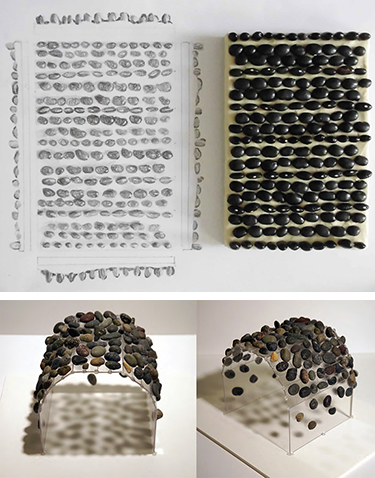
Have you ever gotten a splinter from a rough piece of wood? Did you snuggle with your favorite baby blanket or stuffed toy as a child? Textures are all around us: gravel paths, tree bark, bricks, cat fur, a soft blanket or a stone wall. Texture adds variety, interest and contrast to objects, art, and even buildings – outside and inside. There are three categories of texture: tactile, visual, and audible. Tactile texture is the feel of a material to human touch. Visual texture affects how an object or room looks, and audible texture affects how the object or room sounds. Texture can be very important, especially for people who cannot see and rely on their sense of touch to identify things; they even read using braille.
Depending on the surfaces of materials used, sounds in a room can be amplified (made louder) or dampened (made softer). Audible texture also refers to how a surface sounds when rubbed. Touch texture!
Activity 1 – Texture Rubbings

You will need some paper and crayons, charcoal, or pencils. First, choose several objects such as coins, rocks, fabric, sea shells, clothing, wood, etc. Place a piece of paper over the object or surface. Remove the paper from a crayon and break it in half, or use charcoal or pencil. Using the flat long side, press firmly on the paper and make back and forth strokes coloring over the object. Miraculously the hidden object or surface will reveal its texture to you!!! Retrace your steps around your block. This time select 10 textures to rub. Cut out your favorite rubbings and place them in your journal with the date and place. When you travel you can keep a texture record of where you have been, the things that you have touched, and the memories that have touched you!
Activity 2 – Texture Imaging and Mapping

Make copies of some of your textures or use some of the textures shown. Cut and paste the textures into 1) a regular composition and 2) an irregular composition. What is the difference? Where do you think you would use the regular vs. the irregular? Artists and designers work with simulated and actual texture. Paste your texture compositions in your journal and make notes where you might want to use your new visual texture skills! On the computer, you can make a three dimensional shape and map any scanned texture on to it. Check this out at texture mapping. Print your texture mapped object in several texture variations. Print and paste them in your journal.
Activity 3 – Texture Experiencing

Take a walk around your school or house block. Using your drawing abilities or a digital camera, see how many different textures you can find. Interior designers, architects, landscape architects and industrial designers all use different textures to create contrast with brick, fabrics, wood, plaster, metal, glass, paper, plastic and paint. Actual texture is how surfaces really look, feel and sound. Texture is a source of beauty but can also influence how you see a room. Walls without texture make a room appear larger, while heavily textured walls make rooms seem smaller. Shiny textures reflect light and make rooms seem brighter, but rough textures don’t make the room appear darker. Draw a one point perspective of a room and make copies. Texture each room with a different texture from your texture discovery walk. Study how the different textures make the room seem larger, smaller, darker, and lighter. Label your rooms’ texture and description.
Activity 4 – Texture as Relief

Texture can also be sculptural relief. Look at the work of contemporary artist, Tara Donovan. Think about collecting and using every objects like pins, staples, paper clips, bottle tabs, plastic cups, used tea bags, plastic bags, toilet paper rolls to study textural relief. Acquire a piece of cardboard, wood or foam that can serve as your surface. Explore different effects by varying surface texture through repetition and height differences. Choose one found object that you find interesting to work with and create a textural piece on an 11 x 17" surface. Make a pencil or ink drawing of your creation. Mount them side by side.
Texture enhances experience!
Activity 5 – Textured Space

Texture can also be applied in space. In fact, texture can transform how we experience space. Instead of flat walls, floors and ceilings, texture can change the surfaces so that they absorb sound, refract a view and surround us with shapes and forms and patterns. Create a textured space using one material!
Activity 6 – Textured Form

A textured form is a form that is covered in relief. It is a form that has folds, or waves, or spikes, or tiles, or a sandy appearance. Nature has many textured forms from fish to insects to animals to plants. Architecture can be created with textured forms, too! Texture in architecture is created by patterns or repeated smaller scale forms or tessellation of interlocking forms, gridded forms, irregular forms. Create a textured form in model and imagine it is a building!
Review
- What kinds of textures would you use in a performance hall? Remember, you want to be able to hear the performers but not other noises.
- What are the three kinds of textures?
- Making rubbings helps us understand the quality of the surface of a material.
- How do artists use texture?
- Texture cannot be used to enrich the visual and audible experience of an object or environment.



















































